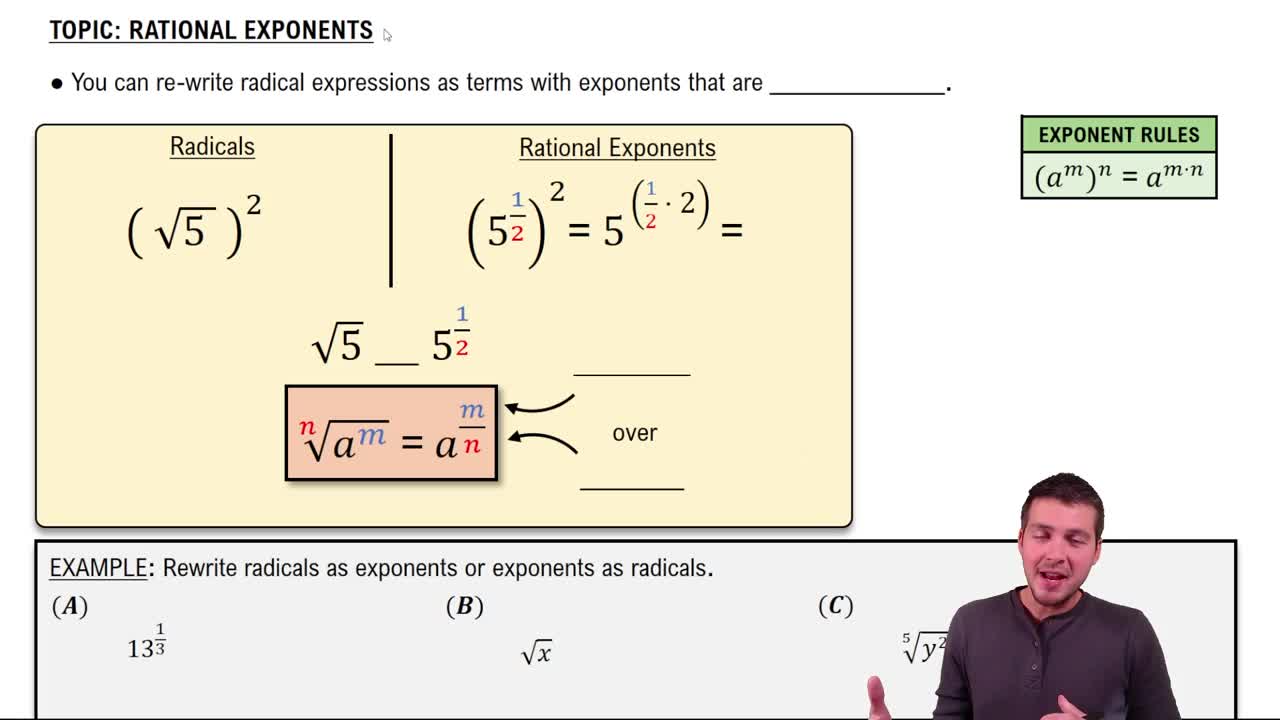Table of contents
- 0. Review of Algebra4h 16m
- 1. Equations & Inequalities3h 18m
- 2. Graphs of Equations43m
- 3. Functions2h 17m
- 4. Polynomial Functions1h 44m
- 5. Rational Functions1h 23m
- 6. Exponential & Logarithmic Functions2h 28m
- 7. Systems of Equations & Matrices4h 6m
- 8. Conic Sections2h 23m
- 9. Sequences, Series, & Induction1h 19m
- 10. Combinatorics & Probability1h 45m
0. Review of Algebra
Radical Expressions
Problem 21c
Textbook Question
In Exercises 21–38, rewrite each expression with rational exponents. _ √7
 Verified step by step guidance
Verified step by step guidance1
Identify the expression given: \( \sqrt{7} \).
Recall that a square root can be expressed as a rational exponent. The square root of a number \( a \) is equivalent to \( a^{1/2} \).
Apply this rule to the expression: \( \sqrt{7} = 7^{1/2} \).
The expression \( 7^{1/2} \) is the rewritten form of \( \sqrt{7} \) using rational exponents.
Verify that the expression is now in the form of a rational exponent, which is \( 7^{1/2} \).
Recommended similar problem, with video answer:
 Verified Solution
Verified SolutionThis video solution was recommended by our tutors as helpful for the problem above
Video duration:
1mPlay a video:
Was this helpful?
Key Concepts
Here are the essential concepts you must grasp in order to answer the question correctly.
Rational Exponents
Rational exponents are exponents that can be expressed as a fraction, where the numerator indicates the power and the denominator indicates the root. For example, an exponent of 1/2 represents the square root, while 1/3 represents the cube root. This notation allows for a more compact representation of roots and powers, facilitating easier manipulation of expressions in algebra.
Recommended video:
Guided course

Rational Exponents
Radical Notation
Radical notation is a way to express roots using the radical symbol (√). For instance, √a denotes the square root of 'a'. Understanding how to convert between radical notation and rational exponents is crucial, as it allows for the simplification and rewriting of expressions in different forms, which is often required in algebraic operations.
Recommended video:
Guided course

Expanding Radicals
Properties of Exponents
The properties of exponents are rules that govern how to manipulate expressions involving exponents. Key properties include the product of powers, quotient of powers, and power of a power. These properties are essential for simplifying expressions and solving equations, especially when converting between radical and rational exponent forms.
Recommended video:
Guided course

Rational Exponents
Related Videos
Related Practice













